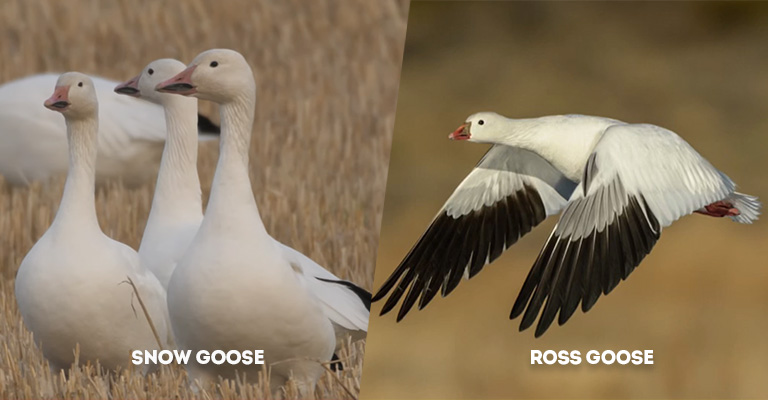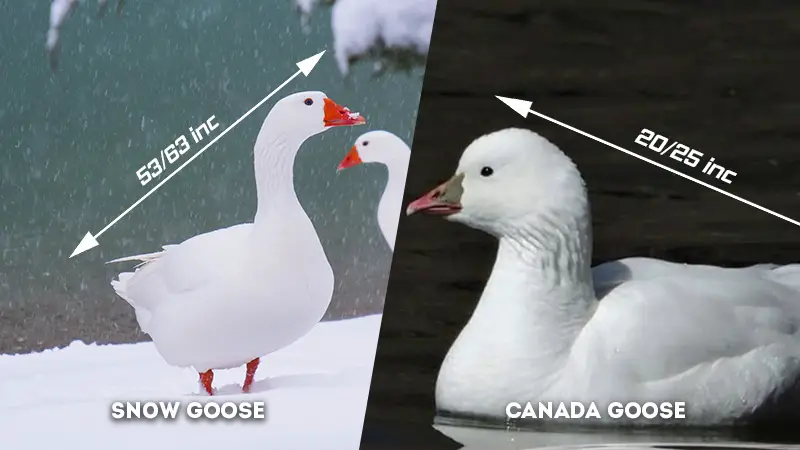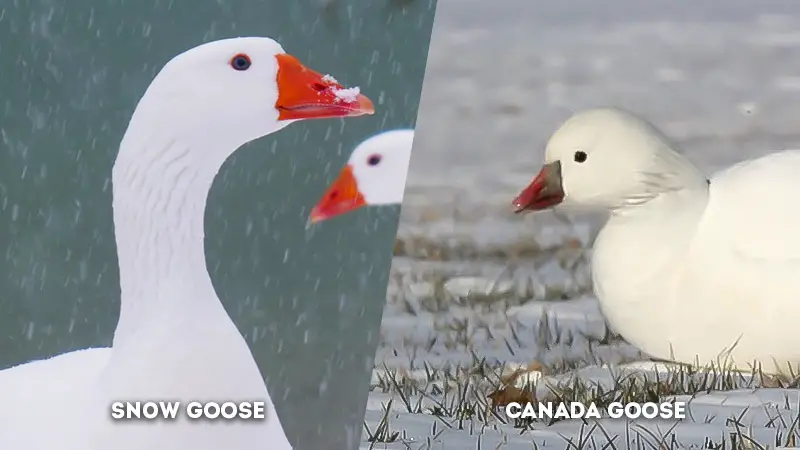The Snow Goose and Ross’s Goose, two closely related waterfowl species, share an intriguing blend of similarities and differences that contribute to their distinctive identities.
While they bear resemblances in appearance, their nuanced characteristics in terms of size, plumage, behavior, and habitat preferences set them apart.
Exploring these intricacies enhances our understanding of the intricate web of life within the avian world and highlights the remarkable ways in which nature adapts species to thrive in diverse environments.

Key Differences Between Snow Goose and Ross’s Goose
Size

- Snow Goose: One of the most apparent differences between the Snow Goose and Ross’s Goose is their size. The Snow Goose is notably larger than its counterpart.
With a wingspan ranging from 53 to 63 inches and a length of 27 to 33 inches, Snow Geese have a more imposing presence in comparison. This larger size contributes to their relatively heavier build. - Ross’s Goose: In contrast, the Ross’s Goose is significantly smaller. Its wingspan spans about 45 to 51 inches, and its length ranges from 20 to 25 inches. The compact build of the Ross’s Goose is a distinguishing feature that sets it apart from the Snow Goose.
Plumage
- Snow Goose: Another critical distinction lies in their plumage. Snow Geese have a white plumage that contrasts dramatically with their black wingtips.
This coloration is especially pronounced during flight, making them easily identifiable. Additionally, Snow Geese can exhibit two distinct color morphs: the white morph and the blue morph, with the former being more common. - Ross’s Goose: Ross’s Geese, on the other hand, possess a mostly white plumage without the striking black wingtips that characterize Snow Geese. This uniform white appearance contributes to their subtle and more understated presence.
Bill Size
- Snow Goose: The size of the bill is a notable feature that distinguishes the two species. Snow Geese have larger bills that are proportionate to their overall size. This adaptation aids in their feeding habits and allows them to graze on vegetation more effectively.
- Ross’s Goose: In contrast, Ross’s Geese possess smaller and stubbier bills. This difference in bill size reflects their distinct dietary preferences and foraging behaviors. The size of the bill is intricately linked to their feeding habits and adaptations to their respective habitats.
Bill Color
- Snow Goose: The color of the bill is another avenue of differentiation. Snow Geese have pink bills that feature a distinctive black “grin patch” at the base, where the mandibles converge. This black patch is a prominent and easily recognizable feature on their bill.
- Ross’s Goose: The bill of the Ross’s Goose is characterized by a reddish pink hue, with a notable blue-gray base. The absence of the black “grin patch” further sets the Ross’s Goose apart from the Snow Goose in terms of bill coloration.
Wingtips
- Snow Goose: The wingtips of Snow Geese are marked by prominent black coloring. During flight, the contrast between their white body and the black wingtips becomes especially pronounced, aiding in their identification even from a distance.
- Ross’s Goose: Unlike Snow Geese, Ross’s Geese lack the distinct black wingtips. Their wings are uniformly white, which gives them a different appearance in flight compared to Snow Geese.
Voice
- Snow Goose: Snow Geese are known for their loud and resonant honking calls that echo through their habitats. During migration and feeding flights, their calls become particularly intense, filling the air with a distinctive chorus of honks.
This vocalization serves as a means of communication within their flocks, aiding in coordination during their journeys and providing a soundscape that many birdwatchers and enthusiasts can readily identify. - Ross’s Goose: In contrast, Ross’s Geese produce a softer and higher-pitched call that has been likened to a gentle “kuk-kuk.” This vocalization is less intense compared to the honking of Snow Geese.
The difference in their calls reflects their unique communication strategies and the potential adaptations to their specific social dynamics.
Migration
- Snow Goose: Both Snow Geese and Ross’s Geese are migratory species, but their migration patterns and routes differ.
Snow Geese breed in the Arctic tundra and then embark on extensive migrations to wintering grounds in various regions of North America, including the southern United States and Mexico. Their long-distance journeys are often marked by impressive formations and the rhythmic sound of their calls. - Ross’s Goose: Ross’s Geese share a similar breeding habitat in the Arctic tundra with Snow Geese. However, their migration routes take them primarily to the central and western parts of North America, including areas like the Great Plains.
This differentiation in migration routes is a testament to the nuanced variations in ecological preferences between the two species.
Habitat
- Snow Goose: Snow Geese are versatile in their choice of habitats, often frequenting wetlands, open fields, agricultural landscapes, and coastal areas during migration and winter. They are particularly adaptable to human-altered environments and can thrive in both natural and anthropogenic habitats.
- Ross’s Goose: Similarly, Ross’s Geese are also known to inhabit wetlands and open areas, often foraging in fields and wet meadows.
However, they exhibit a preference for freshwater habitats, such as lakes and ponds, during their migration and wintering periods. This habitat specialization aligns with their distinct foraging behaviors and dietary preferences.
Conservation Status
- Snow Goose: Both Snow Geese and Ross’s Geese share a positive conservation status, being categorized as species of least concern. In fact, their populations have experienced increases in recent years.
This resurgence is partly attributed to changes in agricultural practices that provide ample foraging opportunities and suitable habitats for these geese. - Ross’s Goose: Ross’s Geese also enjoy a status of least concern. Their population growth and stability can be attributed to factors such as habitat conservation, managed hunting practices, and the availability of suitable wintering areas.
Behavior
- Snow Goose: While there are behavioral similarities between Snow Geese and Ross’s Geese, there are no significant behavioral differences that fundamentally set the two species apart. Both species exhibit similar social behaviors within their flocks and engage in collective feeding, resting, and migration activities.
- Ross’s Goose: Similarly, Ross’s Geese share common behavioral traits with Snow Geese. Their social interactions, including flock dynamics and group behaviors, align with the behaviors observed in Snow Geese populations.
Feeding Habits
- Snow Goose: Snow Geese are primarily herbivorous birds with a diet heavily focused on vegetation. They graze on grasses, sedges, aquatic plants, and agricultural crops such as grains.
This feeding behavior is often observed in open habitats like fields and wetlands where they can access ample plant resources. Their ability to efficiently process plant material is supported by their unique bill structure. - Ross’s Goose: Similarly, Ross’s Geese are also herbivores that feed on a diet consisting mainly of grasses and aquatic vegetation. Their feeding habits overlap with those of Snow Geese due to their shared preferences for wetland and grassland habitats.
Head Shape

- Snow Goose: The head shape of the Snow Goose is characterized by a slightly rounded appearance, contributing to its classic waterfowl profile. This rounded head is a distinctive feature that distinguishes Snow Geese from other species.
- Ross’s Goose: Ross’s Geese also possess a rounded head shape, aligning with the general anatomical traits of waterfowl. While there are subtle variations in head shape within the Anatidae family, the rounded head is a common characteristic among goose species.
Neck Length
- Snow Goose: The neck length of the Snow Goose is moderate, providing a balanced proportion to its body size. This neck length allows for efficient feeding and access to both aquatic and terrestrial vegetation.
- Ross’s Goose: Ross’s Geese have a shorter neck length compared to Snow Geese. This difference in neck length is not always immediately noticeable but contributes to their overall appearance and posture.
Bill Shape
- Snow Goose: Snow Geese possess a bill that is longer and more tapered, enabling them to effectively grasp and manipulate various types of vegetation. This bill shape aligns with their grazing habits and allows them to feed on a wide range of plant materials.
- Ross’s Goose: In contrast, Ross’s Geese have a shorter and stubbier bill. This bill shape reflects their specialized diet and feeding behavior, which might involve different foraging strategies compared to Snow Geese.
Bill Features
- Snow Goose: One of the most notable differences in bill features between the two species is the presence of a black “grin patch” at the base of the Snow Goose’s bill, where the mandibles come together. This patch is a distinctive and easily recognizable feature.
- Ross’s Goose: Ross’s Geese lack the black “grin patch” on their bills. Instead, their bills are mostly reddish pink with a contrasting blue-gray base. This unique bill coloration sets them apart from Snow Geese.
Bill Color Variation
- Snow Goose: The bill of the Snow Goose is a remarkable feature that showcases a black “grin patch” at the base where the mandibles meet.
This black patch stands in stark contrast to the rest of the bill, which is primarily pink. This unique bill coloration is a defining characteristic of the Snow Goose and aids in its identification. - Ross’s Goose: Ross’s Geese have a distinctive bill coloration as well. Their bills are predominantly reddish pink with a contrasting blue-gray base. Unlike the Snow Goose, Ross’s Geese lack the black “grin patch.”
This difference in bill coloration is one of the key features that help differentiate between the two species.
Body Size
- Snow Goose: Snow Geese are notably larger in size compared to Ross’s Geese. They have a larger wingspan, ranging from 53 to 63 inches, and a length of 27 to 33 inches. This larger size contributes to their relatively heavier build and presence.
- Ross’s Goose: In contrast, Ross’s Geese are significantly smaller. Their wingspan spans about 45 to 51 inches, and their length ranges from 20 to 25 inches. The compact build of the Ross’s Goose is a distinguishing feature that sets it apart from the Snow Goose.
Color Morphs
- Snow Goose: Snow Geese exhibit interesting color morphs. The most common morph is the white morph, where their plumage is entirely white.
However, there is also a blue morph, in which their plumage is darker with a bluish-gray tint. This color variation adds an extra layer of diversity to Snow Goose populations. - Ross’s Goose: In contrast, Ross’s Geese do not exhibit distinct color morphs like the Snow Goose. Their plumage remains relatively consistent across individuals, with an overall white appearance.
Flight Pattern
- Snow Goose: The flight pattern of Snow Geese is marked by slower and heavier movements. During their migrations, they often form impressive V-shaped formations that fill the skies with their calls and synchronized movements. Their larger size contributes to their slightly slower and more deliberate flight style.
- Ross’s Goose: Ross’s Geese exhibit a faster and more agile flight pattern compared to Snow Geese. Their smaller size and different wing structure allow them to execute more nimble maneuvers in flight.
Breeding Grounds
- Snow Goose: Both Snow Geese and Ross’s Geese share similar breeding grounds in the Arctic tundra. These areas provide suitable nesting habitats for both species, as the tundra’s vegetation and open landscapes offer ideal conditions for raising their young.
- Ross’s Goose: Ross’s Geese, like Snow Geese, breed in the Arctic tundra regions. This shared breeding habitat reflects the commonalities between the two species’ ecological requirements.
Wintering Areas
- Snow Goose: Snow Geese undertake extensive migrations to their wintering areas. They can be found in various regions of North America, including the southern United States and Mexico. These wintering areas offer milder climates and abundant food resources.
- Ross’s Goose: Ross’s Geese also migrate to wintering areas in North America, primarily in the central and western parts of the continent, including areas like the Great Plains. Their wintering habitats align with their migratory routes and preferences.
Snow Goose Vs Ross Goose: Comparison Table
| Characteristic | Snow Goose | Ross’s Goose |
|---|---|---|
| Size | Larger | Smaller |
| Plumage | White with black wingtips (two color morphs) | Mostly white |
| Bill Size | Large | Small and stubby |
| Bill Color | Pink with black “grin patch” | Reddish pink with blue-gray base |
| Wingtips | Black during flight | No black wingtips |
| Voice | Loud honking calls | Soft “kuk-kuk” sound |
| Migration | Migratory, breeds in Arctic, winters in North America | Migratory, breeds in Arctic, winters in North America |
| Habitat | Wetlands, agricultural fields, open habitats | Wetlands, agricultural fields, open habitats |
| Conservation Status | Least concern | Least concern |
| Behavior | No significant behavioral differences | No significant behavioral differences |
| Feeding Habits | Herbivorous, grazes on vegetation | Herbivorous, grazes on vegetation |
| Head Shape | Rounded head | Rounded head |
| Neck Length | Moderate length | Shorter neck |
| Bill Shape | Longer and more tapered | Shorter and stubbier |
| Bill Features | Black “grin patch” at bill base | No black “grin patch” |
| Bill Color Variation | Pink with black on bill | Reddish pink with blue-gray base |
| Body Size | Larger body size compared to Ross’s Goose | Smaller body size compared to Snow Goose |
| Color Morphs | Two color morphs: white and blue | No distinct color morphs |
| Flight Pattern | Slower and heavier flight | Faster and more agile flight |
| Breeding Grounds | Arctic tundra | Arctic tundra |
| Wintering Areas | Southern United States, Mexico | Southern United States, Mexico |
Frequently Asked Questions
Yes, both Snow Geese and Ross’s Geese are highly social birds that often gather in large flocks. These flocks aid in various activities such as foraging, migration, and providing protection from predators.
Snow Geese communicate through loud honking calls, especially during migration and feeding flights. Ross’s Geese, on the other hand, produce softer and higher-pitched “kuk-kuk” sounds as a means of communication within their flocks.
Yes, both species engage in elaborate courtship displays during the breeding season. These displays involve synchronized movements, calls, and postures that contribute to pair formation and mate selection.
Both species play essential roles in their ecosystems. By foraging on vegetation, they help control plant growth in wetland and grassland habitats. Additionally, their migration patterns can distribute nutrients and affect the ecology of various areas they visit.
The Arctic breeding grounds provide a critical safe haven for both Snow Geese and Ross’s Geese during the breeding season. The remote and pristine nature of these regions offers suitable conditions for nesting, rearing young, and maintaining the health of their populations.
To Recap
The Snow Goose and Ross’s Goose exemplify the intricacies of nature’s diversity. Through their unique attributes spanning from bill features and migration routes to vocalizations and ecological roles, these geese demonstrate the marvel of adaptation.
Embracing their distinctions enriches our appreciation for the rich tapestry of life, reminding us that even seemingly similar species are woven with threads of individuality.
As these geese continue their migratory journeys and interactions with their habitats, they stand as testament to the intricate dance of evolution and the beauty of biodiversity.
